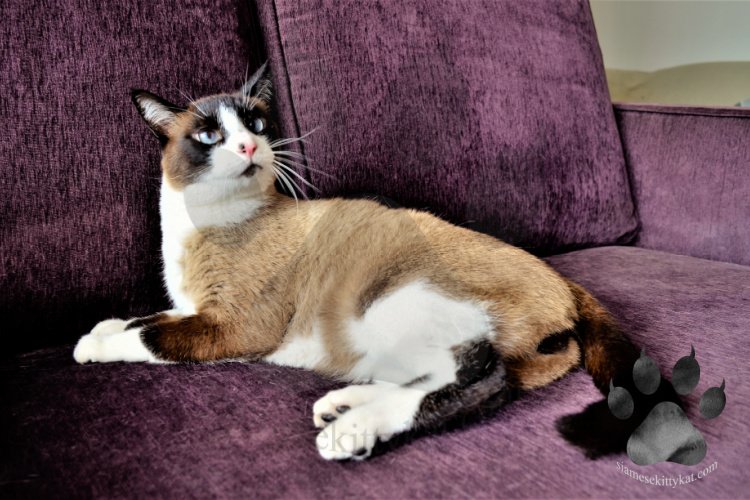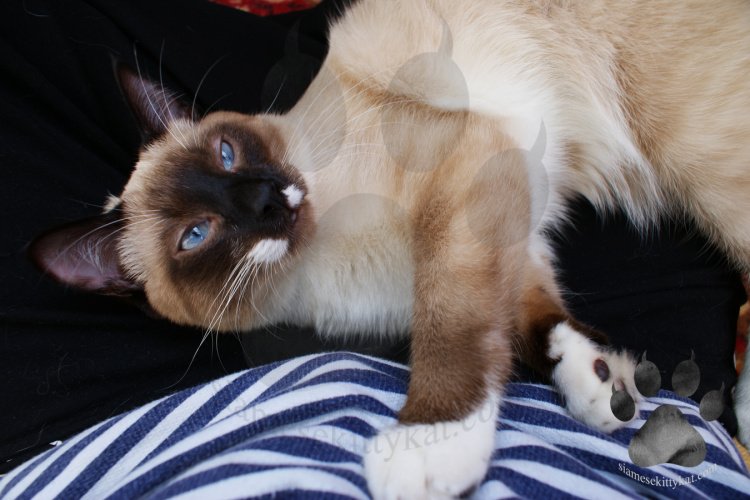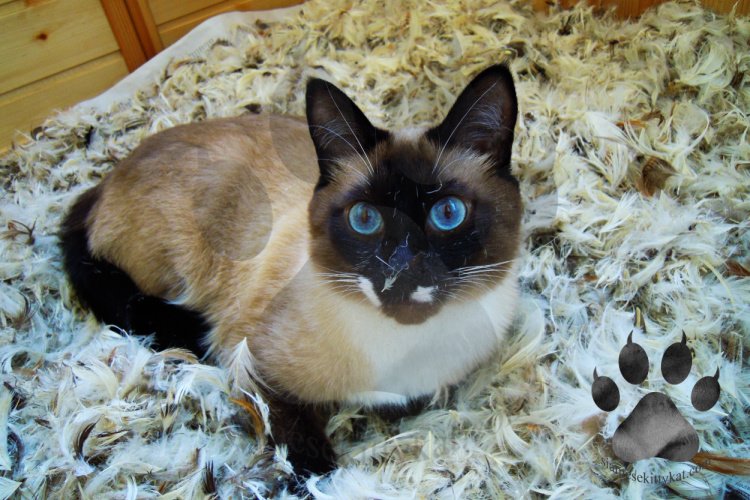The beginnings of the beautiful Snowshoe date back to Victorian times, when an old photograph of a purebred litter of Siamese kittens were found with one kitten sporting all-white paws.
While the Snowshoe is a relatively new breed, both the evidence in the photograph and found on an old Japanese silk-screen show they may have been around long before we knew.
Undoubtedly, the Snowshoe shares its ancestry with both the Siamese and Birman. That being said, Snowshoe Siamese have their own unique personality and features that most, including myself, love them for.
If you’re considering bringing a Snowshoe Siamese into your home, check this quick guide I drafted up using both my experience and hours upon hours of research; enjoy!
Are Snowshoe Siamese cats purebred?
No, Snowshoe Siamese cats are not purebred, since the Snowshoe and Siamese are two different breeds. The Snowshoe Siamese came about by crossing a Seal Point Siamese with an American Shorthair; that’s why they take qualities from both breeds.
Snowshoe Siamese are, however, fully recognized by both the Fédération Internationale Féline and the Cat Fanciers Federation; therefore, they can compete in shows and are recognized as a breed in their own right.
What is the history of the Snowshoe Siamese?
The history of the Snowshoe Siamese is a rather interesting one. Just like many of the color point Siamese, they had their own struggles when it came to being recognized as an official breed.
Way back in the ’50s, the first attempt of establishing the Snowshoe was made, with an alternative name of “Silver Laces.” Unfortunately, the breed was short-lived until Dorothy Hinds-Daugherty, a Siamese breeder, attempted to bring back the breed and name it “Snowshoe” in the ’60s.
She promoted her Snowshoe at local shows, developing a rudimentary standard. She managed to get her Snowshoe breed approved with this standard, but for Exhibition only.
Unfortunately, what comes up must come down. And again, in 1977, after working on the Snowshoe breed for seventeen years, only four Snowshoes had been registered, and it looked like the fade-out was eminent.
Then came Jim Hoffman, who managed to get the ball rolling again, as the Snowshoe was officially recognized in 1982 for Championship status. Shortly after, the CAT FANCY and CAT ran articles on the Snowshoe, listing them in their Breed Directories.
More breeders were introduced in 1982, and by 1990, the first Snowshoe grand champion was crowned in Kansas!
These days, the Snowshoe is fully recognized as a breed in their own right, with their own show standards and breeding. But it’s safe to say they had a somewhat rocky start.
We might not have had our white-footed Siamese today if it weren’t for everyone who stuck it out for the Snowshoe!
Are Snowshoe and Siamese the same?
You can think of a Snowshoe more like the cousin of the Siamese, and they’re definitely related, but the Snowshoe has a sprinkle of American Shorthair.
Snowshoes also look pretty different from Siamese kitties yet have similar features, such as their striking blue-eyes.
That being said, I wouldn’t be surprised if someone told me they thought the Snowshoe and Siamese weren’t related at all. Some Snowshoe kitties don’t resemble Siamese cats at all, not in color, height, or weight.
What does a Snowshoe Siamese look like?

There’s no denying that Snowshoe kitties are gorgeous! A friend of mine once had a Snowshoe named Snowy (very original, I know), and Snowy’s eyes were an even brighter blue than my Siamese’s.
You’ll know a Snowshoe by their distinctive coat and color markings, which they actually inherit from the Siamese. Snowshoe kittens are born all white and develop their color later on in life (doesn’t that sound familiar?) and can sport color points such as white, cream, seal, blue, chocolate, and lilac.
The difference between a purebred Siamese coat and a Snowshoe Siamese is the “tuxedo” causing their paws to stay white throughout their entire lives; hence the name “Snowshoe.” This tuxedo gene is inherited from the American Shorthair.
Snowshoe Siamese are often tricolor in nature and tend to have darker coats than the regular Siamese.
The Snowshoe has a fuller face and body compared to their Siamese cousins, with a bulkier muscle tone more similar to an American Shorthair.
Typically, a Snowshoe will have a triangular head with long ears; however, you may come across one with a round head and rounded ears.
Just like Siamese kitties, Snowshoe’s always have sparkling blue eyes!
Are Snowshoe Siamese cats rare?
Yes! Snowshoe cats are a rare breed, partly down to how difficult they are to master the specific markings and patterns that fit the breed standards.
There are many things to take into consideration when breeding a Snowshoe, and to be quite honest; it’s all a little complicated for me!
Since I’m not a scientist, I can’t say I know much, but I’ll share one little fact that hopefully makes it easier to understand the inner workings.
The white boots that make the Snowshoe special are caused by a gloving gene. This gene is super difficult to control, and many Snowshoe can hit complications such as:
As perfect as these kitties may seem to us, unfortunately, irregular boots are not accepted when it comes to shows.
How much does a Snowshoe Siamese cat cost?
A Snowshoe Siamese generally costs around $600 – $1,200 per kitten, with prices varying depending on championship status and whether or not the kitten comes from show-winning stock. In this case, they will cost far more than your average Snowshoe housecat.
At an average of $900, a Snowshoe Siamese is more expensive than the American Shorthair but costs similar or less to their Siamese cousins.
Due to Snowshoe Siamese cats being rare and popular, it is pretty unlikely that you will come across one in the shelter. Most people with the knowledge of Siamese cats will recognize them as being part Siamese.
What are the Snowshoe breeding standards?
As I mentioned, there are some pretty strict standards regarding the criteria the Snowshoe is judged by. The Snowshoe is currently accepted by the CFF, AACE, ACFA, and TICA.
Head:
Coat:
Paws:
Are Snowshoe Siamese friendly?

Yes! Snowshoes are very similar to Siamese cats when it comes to personality, and this means they are kind, intelligent, and extremely lovable.
They’re not a breed that you can simply leave alone; they demand all of the love you have to give and will give it back to you tenfold! Snowshoe Siamese are a lot similar to dogs, but instead of doing the leading, they’ll follow you like a shadow.
Of course, all Snowshoe have their own personalities. So while the breed tends to be less dramatic than their Siamese cousins, you may have a diva on your hands simply because that’s who they are as a cat!
Snowshoe Siamese and families
Snowshoe Siamese cats make perfect family pets. They are friendly and loving and will get along well with each family member, regardless of age or gender.
These felines are active into old age; therefore, they enjoy being around children and people who can keep up with their high energy. Of course, children should first be taught how to respect your Snowshoe, but when respect is shown, it will be given!
Snowshoe Siamese are also friendly towards strangers, so you won’t have to worry about having friends or family over. If they bring a special toy for your Snowshoe, they’ll be best friends forever!
Snowshoe Siamese and other pets
When introduced correctly, Snowshoe kitties should get along well with other pets.
In fact, just like the Siamese, Snowshoe thrives in pairs, and having a fellow feline around will ensure they don’t get lonely (however, this isn’t a substitute for your time and attention!)
Snowshoe cats can also get along well with dogs if the right steps are taken.
Things to know before owning a Snowshoe Siamese
Before you dive in and bring one of these beautiful kitties home, there are a few things you should know.
Snowshoe Siamese cats make excellent pets, but they may not be the best for first-time owners as they take more time and care than your regular moggie.
Diet & food requirements
Like all felines, the Snowshoe Siamese are obligate carnivores. That means no all-veggie diet for them – only meat and more meat!
Fish, beef, pork, chicken, and whatever protein your Snowshoe enjoys should be their primary nutrient source. Lots of protein and nutrients will help your Snowshoe to stay healthy.
How much your Snowshoe should eat every day depends on their age, weight, and activity level. The type of food, for example, a raw diet vs. a mix of wet and dry, will also be a factor.
If you’re wondering about the benefits of a homemade diet, check out the article I recently wrote where I tested out an all-home-made diet on my two Siamese kitties!
You should expect to feed your Snowshoe around two to three meals per day; however, you should always follow the guidelines given to you by a vet or what food packaging says.
Exercise
Snowshoes are energetic beasts, exactly like their Siamese cousins.
Remember that friend who had the Snowshoe called Snowy? They would regularly compare their kitty to a human child, especially when it came to how much mental and physical stimulation he needed. Snowy would even become mischievous when bored, choosing to tear up the curtains in protest.
Since Snowshoes are both intelligent and energetic, they need plenty of daily exercises. They love to explore and run around, so they would make perfect outdoor kitties.
But, if you’re like me, you’d probably much prefer to keep them indoors (and I do recommend that!) Luckily enough, there are tons of ways to keep them happy and stimulated indoors. Both Batman and Robyn, my Siamese kitties, are indoor cats, and they still thrive and live their best lives.
Ensure your Snowshoe is living in an enriched environment. This includes lots of toys to play with, cat towers where they can climb, and lots of high spaces where they can perch.
Snowshoe Siamese cats adore playing with their owners, so take at least 30 minutes of your day to play one-on-one with your Snowshoe with toys such as laser pointers or fishing rods.
Not only will lots of play benefit your Snowshoe, but it will also benefit you too. It will keep them from being destructive and will also make them less noisy throughout the day and night.
Training
As I mentioned before, Snowshoe Siamese are intelligent. This means that they are pretty easy to train, as long as you have enough time and patience.
Snowshoe kitties will go out of the way to please their owners, so pair that with the ability to learn, and you got yourself the perfect candidate.
If you’d like to begin training your Snowshoe, I suggest using clicker training. This involves rewarding your cat with their favorite treat when they do something good or perform a trick, a simple yet effective bribe!
Care
Since Snowshoe Siamese are short-haired and have a single coat, they’re pretty easy to maintain. I recommend bruising your Snowshoe Siamese once a week; this should be enough to keep their coat looking shiny and happy.
This breed also doesn’t shed much, but they are by no means hypoallergenic. If you have allergies to cats, it’s better to spend time with this breed before you fully commit.
Snowshoes also need their nails trimmed regularly, just like all cats.
Health
Unlike the Siamese, Snowshoes don’t really come with many health issues. This breed can easily reach 20 years old, and they tend to be very healthy and a fairly low-worry breed.
They may pertain to some health concerns similar to the Siamese, such as kinked tails or crossed eyes, but these rarely affect the cats’ health.
Choosing a Snowshoe breeder

While Snowshoes are fairly new breeds, they are on a popularity rise. Due to this, a handful of breeders are simply looking to ride on this and make a quick buck wherever they can.
I advise anyone looking to adopt a Snowshoe, or any breed for that matter, to do their research beforehand. This includes emails, phone calls, and visiting the breeder in person when possible.
Breeders will most likely want to interview potential forever homes, but that doesn’t mean you can do the interviewing too. Ensure you feel comfortable around the breeder; first impressions are everything.
The facility should be clean and managed well, but there should also be genuine love for their cats. Check out references and reviews of any potential breeders, and only deal with the best. As soon as you get an inkling that this person is in it purely for the money, it’s time to get out of there!
Facts about the Snowshoe Siamese
Here are some interesting facts I found about the Snowshoe Siamese.
Pros and cons of the Snowshoe Siamese
Since we’ve gone over quite a bit of information and learned a lot about the Snowshoe Siamese, let’s have a recap!
Pros:
Cons:
Is the Snowshoe Siamese for me?
Snowshoe Siamese cats are known for their unique looks, sporting a V-like face marking and little white boots. Being closely related to Siamese cats, they inherited many of their personality traits, such as being friendly, intelligent, and a little bit clingy.
If you’re hoping to get a cat that will mind its own business and keep you company now and again, the Snowshoe isn’t for you. You need to devote a lot of time and attention as they don’t like to be left alone for too long and can quickly become destructive when bored.
That being said, it really isn’t hard to take care of a Snowshoe. As long as you give them enough love, time, and attention, you’ll have yourself a loyal friend for life!
Be the Siamese Cat expert you always wish to be! From color points to similar cat breeds, discover everything you need to know about their unique charm and characteristics in our comprehensive guide: Siamese Cat Breed: Types, Color Points and Comparison to Other Cat Breeds
Get your FREE Siamese Cat 2024 Printable Calendar


